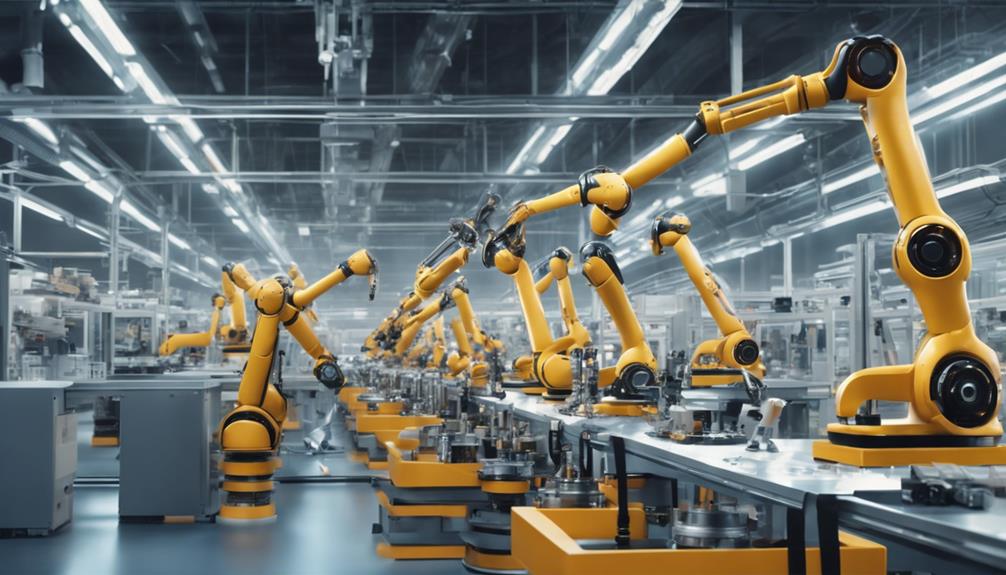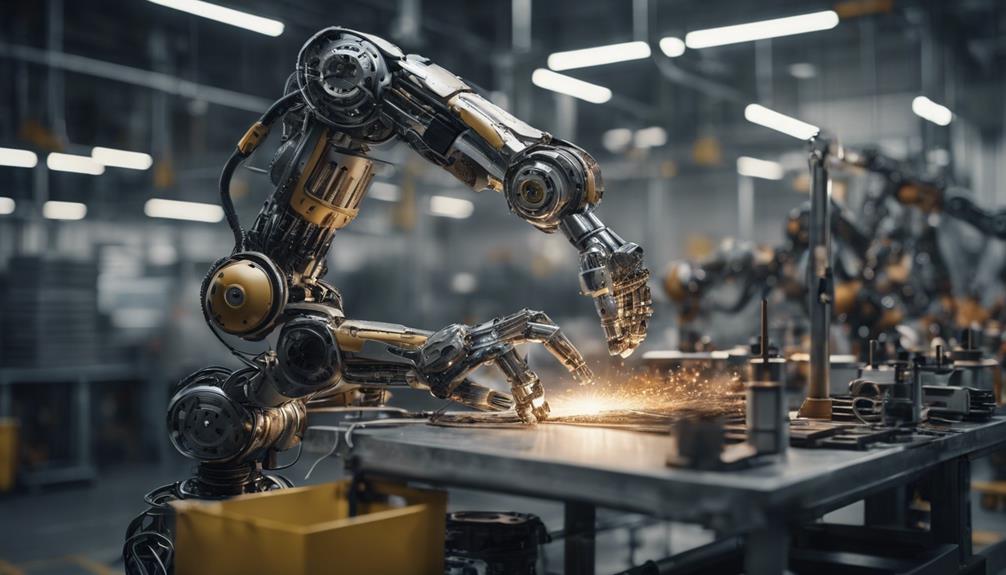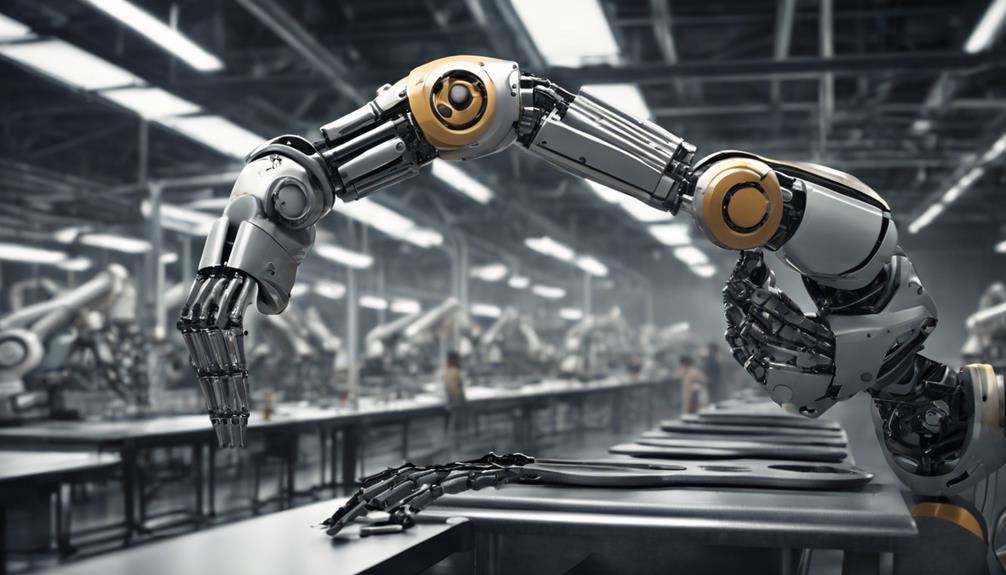The constant progression of artificial intelligence in the realm of physical tasks points to a major shift in the workplace. As AI technologies continue to improve in their ability to complete tasks with precision and speed, the impact on industries and job markets is far-reaching.
The efficiency gains promised by AI automation are undeniable, yet the broader implications for society and the workforce remain a subject of intense scrutiny. In exploring how AI will supplant manual tasks efficiently, one must consider not just the immediate benefits but also the ripple effects that will shape the future of work in ways both profound and nuanced.
Key Takeaways
- AI automation optimizes manual tasks, increasing efficiency.
- Robotics and machine learning streamline labor-intensive processes.
- AI integration reduces errors, enhances productivity, and lowers costs.
- Upskilling programs prepare workforce for evolving AI automation challenges.
Impact of AI on Manual Tasks
The integration of AI technology is revolutionizing manual tasks across industries, fundamentally transforming traditional workflows and operational processes. Artificial Intelligence (AI) automation has enabled the streamlining of tasks such as data entry, assembly-line work, and transportation, previously performed by human workers. Machine learning, a subset of AI, plays a pivotal role in enhancing the efficiency and productivity of industries reliant on manual labor.
AI's ability to replace low-skill manual jobs has raised concerns about job displacement among human workers. However, this shift also opens new opportunities for individuals to upskill and transition to roles that require advanced cognitive abilities and creativity. The utilization of AI in automation not only boosts productivity but also reduces costs and minimizes errors in manual tasks.
As AI-driven automation continues to advance, industries must reevaluate the skill sets required for future employment. This paradigm shift underscores the importance of adapting to the evolving landscape where AI complements human intelligence, creating a symbiotic relationship between technology and the workforce.
Job Roles Replaced by AI

AI's disruptive impact on manual tasks extends beyond streamlining operations, manifesting in the replacement of specific job roles. Industries such as manufacturing, logistics, and customer service are witnessing the gradual replacement of manual labor jobs by AI-driven automation.
Automation technologies excel at efficiently handling repetitive, low-skill tasks like data entry, assembly-line work, and transportation, leading to increased efficiency and accuracy. Machine learning, robotics, and automation play pivotal roles in enhancing productivity by taking over manual labor-intensive tasks.
While the displacement of these manual jobs raises concerns, it also paves the way for new opportunities in emerging fields that require advanced skills in AI and automation. This shift reshapes the workforce dynamics, emphasizing the need for upskilling and reevaluation of skill sets to align with the demands of the evolving job market.
As AI continues to advance, job roles that primarily rely on manual tasks are likely to see further transformations, emphasizing the importance of adapting to the changing landscape of work.
Benefits of AI Automation
Enhancing operational efficiency through advanced automation technologies, AI offers significant benefits in streamlining manual tasks across various industries. AI automation has the potential to replace up to 25% of current work tasks efficiently by 2025, leading to reduced errors and increased productivity in manual tasks.
Robotics, a key automation technology driven by AI, plays a crucial role in streamlining manufacturing processes effectively, especially in tasks requiring precision and repetition. AI excels in automating repetitive manual tasks like data entry and assembly-line work, freeing up human resources for more strategic and creative endeavors.
In industries such as logistics, AI automation enhances operational efficiency significantly by optimizing routes, managing inventory, and automating warehouse operations. This advancement in automation marks a new era in the industrial revolution, where AI-driven technologies are revolutionizing how businesses operate, driving efficiency, productivity, and competitiveness to new heights.
AI's Role in Workforce Evolution

In the transformative landscape of modern industries, the evolution of the workforce is underscored by the pervasive impact of AI technologies on job roles and functions. AI, through machine learning and large language models (LLMs), is reshaping how tasks such as data processing are handled.
While AI is automating routine and mundane tasks, it is also being used to augment human capabilities in making critical decisions. AI's role in workforce evolution extends beyond automation; it includes generative AI tools that enhance creativity in fields such as design and content creation.
In logistics and even customer service, AI is streamlining processes, leading to increased efficiency and improved customer experiences. As AI continues to advance, it will reduce the number of repetitive tasks while empowering employees to focus on more strategic and value-adding activities.
The integration of AI in various industries signifies a shift towards a more efficient and dynamic workforce where human ingenuity is complemented by artificial intelligence.
Preparing for AI Integration
The imperative shift towards AI integration necessitates a strategic focus on upskilling and retraining initiatives to ensure workforce readiness in the evolving technological landscape. Organizations are recognizing the need to upskill their existing workforce to meet the challenges posed by AI automation. In response to the changing job market influenced by AI, half of IT employers are investing in upskilling programs for their employees. The adoption of emerging technologies such as AI and virtual reality for hiring and training purposes is aiding in preparing the workforce for AI integration.
As AI increasingly takes on manual tasks, retraining employees has become crucial to align job requirements with the evolving technological landscape. Apprenticeship programs, particularly in high-demand areas like cybersecurity, are on the rise to cater to the needs of AI-driven job roles. By investing in upskilling, retraining, and specialized programs like apprenticeships, organizations can ensure that their workforce remains competitive and adaptable in the era of AI integration.
Frequently Asked Questions
How Can AI Automate Manual Tasks?
AI automates manual tasks by leveraging machine learning and robotics to process data and perform tasks accurately. Through algorithms and AI-driven automation, repetitive and low-skill tasks are efficiently handled, enhancing productivity and reducing errors.
How AI Can Improve Workplace Efficiency?
AI enhances workplace efficiency by automating tasks, reducing errors, and increasing productivity. Through streamlining processes, AI saves businesses significant labor costs. This technology allows human workers to focus on creativity and strategy, ultimately driving overall productivity.
What Happened When Manual Operations Are Being Replaced by Automation?
When manual operations are replaced by automation, efficiency increases, errors decrease, and processes are streamlined. The displacement of manual labor jobs creates concerns but also opens doors to new opportunities in high-skilled roles, reshaping job requirements towards higher-value tasks.
Does AI Affect Manual?
AI significantly impacts manual tasks by automating processes, enhancing efficiency, reducing errors, and increasing productivity across various industries. This shift necessitates a focus on developing advanced skills to adapt to the evolving job market landscape.
Conclusion
In conclusion, the integration of AI in replacing manual tasks is a significant step towards enhancing efficiency and productivity in various industries. While concerns may arise about job displacement, the benefits of AI automation in streamlining operations and reducing costs cannot be overlooked.
As technology continues to evolve, it is essential for individuals to adapt and acquire new skill sets to thrive in the changing workforce landscape. One anticipated objection may be the fear of job loss, but the opportunities for growth and innovation through AI integration far outweigh the challenges.
Ava combines her extensive experience in the press industry with a profound understanding of artificial intelligence to deliver news stories that are not only timely but also deeply informed by the technological undercurrents shaping our world. Her keen eye for the societal impacts of AI innovations enables Press Report to provide nuanced coverage of technology-related developments, highlighting their broader implications for readers.










